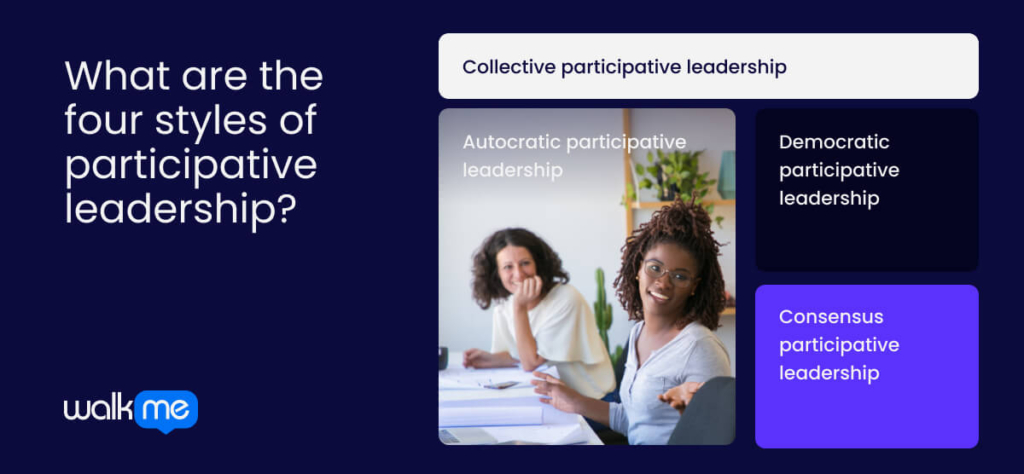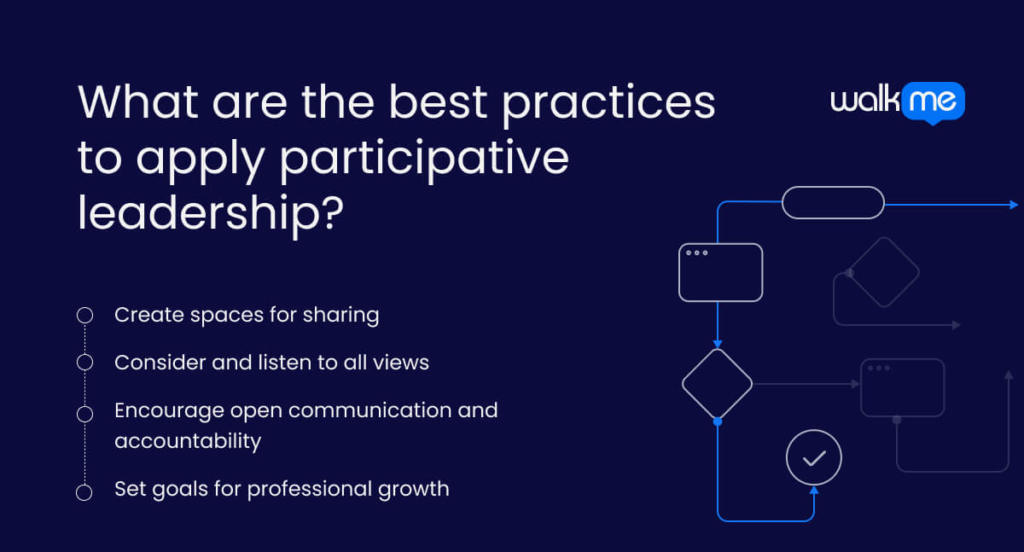Organizational transformation often depends on leadership style—how well a leader makes decisions and enhances employee engagement. Today, employees don’t want to just follow orders. They want to feel valued, contribute, and have a sense of purpose.
Participative leadership involves employees in decision-making and values their input. It’s an inclusive approach that gives importance to each team member.
In this article, we’ll explain this leadership style, explore four types, give examples, and consider its pros and cons.
What is participative leadership?
Participative leadership is a leadership style that focuses on getting all team members involved in decision-making. For this to work well, managers need to share information with their teams regularly. This helps team members give informed input on important choices.
Leaders must listen to their employees and encourage them to share their ideas and opinions. Additionally, leaders need to delegate tasks to get everyone involved.
The main goal of participative leadership is to encourage teamwork. Team members take responsibility for their roles. They work together to solve problems. When employees collaborate, they can find more creative solutions.
What are the four styles of participative leadership?

The four main styles of participative leadership are:
Collective participative leadership
In collective participative leadership, the whole group shares responsibility. The leader helps guide the process, but everyone in the group is responsible for the process and the outcome.
Most members must agree before making a decision. Employees discuss and work together to decide on changes. They do this before creating new rules or policies.
Autocratic participative leadership
Autocratic participative leadership has the least employee involvement. But it still values input. In this style, team members share ideas during brainstorming. The leader makes the final decision alone. The leader takes full responsibility for the outcome.
This decision-making style can be faster, focused on goals, and improved by the team’s input.
Democratic participative leadership
The democratic approach involves getting input from the whole team on big decisions. But, with this participative leadership style, upper management makes the final choice. A democratic leader is expected to explain the reasons behind their decision.
Consensus participative leadership
Leaders who use consensus participation act as facilitators. They encourage employees to agree on a decision the whole group can accept. This leadership style gives each employee a vote in making decisions.
The team must work together to reach a shared decision. This often means team members must compromise to get everyone on board with one plan.
What are the main traits of participative leaders?
The core characteristics of participative leaders are:
A penchant for teamwork
A good participative leader uses teamwork to combine ideas and people in new ways. This helps different projects succeed. By bringing together various perspectives and experiences, leaders achieve goals that were once hard to reach.
Participative leaders know everyone has a unique viewpoint. Using these insights creates stronger results than working alone.
Empathy
Empathy means understanding and relating to someone else’s thoughts, feelings, or experiences. Leaders with high empathy can see things from another person’s point of view. They lead with kindness.
In the digital workplace, empathetic leaders build strong connections with their teams. This improves relationships and performance. When team members feel recognized, they are more engaged.
A focus on team growth
Participative leaders will show interest in their team’s growth. They look for ways to help colleagues improve their skills or better understand their roles.
They might work with HR to set up workshops on assertive communication or mental health. What employees learn in these sessions can help them solve problems in their personal and professional lives.
Communication
Good communication skills are important for a participative leader. Part of this is creating a space where people feel comfortable sharing ideas.
To get everyone’s input, the leader must ensure conversations are open and welcoming. When people feel comfortable, they are likelier to share their honest opinions.
For participative leadership to work, it’s important to hear everyone’s thoughts on decisions.
Receptive
A participative leader keeps everyone happy by considering different ideas and ways to get things done.
In the real world, this leadership style works well by involving the team in decision-making. When the leader trusts the team to find solutions, the team feels motivated. They believe a leader values their ideas and skills. This makes them want to do their best.
What are some examples of participative leaders?
The best examples are participative leaders in real life are:
Jim Lentz
Jim Lentz, the president and CEO of Toyota Motor North America, is a great example of how teamwork and communication can solve problems. Over the years, he has learned that being a strict, controlling boss doesn’t work well and doesn’t motivate people.
Instead, Lentz enjoyed seeing employees grow and succeed in the company. He believed they were the future leaders. By focusing on developing people from within, Toyota could continue its success.
Indra Nooyi
Indra Nooyi, the former CEO of PepsiCo, empowered her employees by involving them in decision-making. She listened to their opinions and created a supportive, team-focused environment. This approach helped PepsiCo grow and innovate under her leadership.
Nooyi also showed great empathy and understanding. These qualities helped her connect personally with employees and build trust and belonging in the company.
Bill Gates
In Microsoft’s early years, Bill Gates used a very autocratic leadership style. He made most of the important decisions himself.
Later, he switched to a more participative approach. Gates started to empower and mentor his employees. He encouraged creativity and open communication at all levels.
Gates also began delegating more responsibilities to other leaders, which allowed him to focus on long-term goals and strategic plans.
What are the best practices to apply participative leadership?

The most important best practices for applying participative leadership are:
Create spaces for sharing
To break down silos, companies should create spaces where you can expect and encourage participation. This helps boost creativity and innovation. You can set up virtual spaces where everyone can share their thoughts and be heard.
Consider using virtual message boards or platforms for regular idea sharing. This allows teams to send ideas as they come up. It also lets others respond to those suggestions. When all team members can share their ideas, you gain many creative options for your strategy.
Consider and listen to all views
It’s vital to consider all employee views when making a decision. In most cases, some people may not agree with the majority. As part of participative leadership, leaders must work with these dissenters to persuade them to accept the group’s choice.
It’s more effective to listen to their concerns. Then, the leader and other team members can offer counterarguments to help change their minds. Sometimes, a compromise may be needed to win over those who are unsure.
Regular meetings with teams and individuals allow employees to share their opinions and suggestions. This approach boosts employee morale through shared responsibility.
Encourage open communication and accountability
Participative leaders share responsibilities with employees, letting everyone contribute to decisions. This style focuses on teamwork and shared accountability, so no one person is blamed for problems.
Honest communication is also key. Employees are encouraged to share real concerns and ideas. This builds trust between leaders and teams.
Leaders must value others’ opinions to create accountability and transparency. Respecting others’ ideas builds trust and loyalty, which are key to long-term success.
Set goals for professional growth
Setting goals lets you choose what to focus on and how to get there. This way, you make progress every day.
Before setting professional goals, know where you’re heading. Goal-setting is key to any career plan.
Make sure your plan is reviewed regularly. Set short-term goals, like six months, to stay motivated with quick wins.
If you’re unsure about your future, start with your interests. For example, if you admire your manager’s active listening skills, take a course.
What are the benefits of participative leadership?
The core benefits of participative leadership are:
Improves team collaboration
Most organizations want to improve how their teams work together to reach big goals. This only happens when teams are close and can rely on each other. Participative leadership gives regular chances for team building. It helps grow trust and reliability.
Better job satisfaction
When employees help make decisions, they feel more responsible and committed to the company. This boosts their motivation, productivity, and satisfaction. Engaged workers are more likely to do extra in their jobs.
This leads to better overall performance. When employees feel valued and trusted, they also think more positively about their work environment. This creates better relationships and open communication.
Encourages independent thinking
Employees may need less supervision if they help decide about new processes and policies. Since they were involved, they already knew what to do. They also know how to do it. For example, if a company picks a new digital tool, employees might already know how to use it. In this way, you empower them to think outside the box.
What are the challenges of implementing participative leadership?
The vital challenges of implementing participative leadership are:
Greater costs
Participative leadership can be costly because it takes time. Team members may lose time for their regular tasks during these group decisions. A good participative leader can manage workloads, ensuring enough support to meet business goals. You can still hold group discussions while balancing day-to-day responsibilities.
Longer decision-making process
One big downside of this leadership style is how long it can take to agree on a decision. Getting everyone’s input takes time, so leaders need to be aware of that.
However, a skilled participative leader might use this group of employees to make smaller decisions. Then, they can handle the most important ones. This way, urgent decisions can be made quickly without wasting time.
Peer pressure
Some workers may feel pressure to follow what the group or their bosses want, making it hard to make a fair group decision. For instance, a junior employee might agree with management to keep their job safe.
Or, they may support a popular coworker to fit in instead of sharing their real thoughts. To fix this, you could use anonymous surveys or talk to employees one-on-one to ensure you listen to their opinions.
Encouraging collaboration when making decisions
Participative leadership involves employees in decision-making. Leaders ask for their input to create a team-focused and inclusive workplace. This leadership style uses the team’s shared knowledge to improve decisions.
Leaders need to listen to different ideas in a diverse workforce. Participative leadership boosts employee experience, job satisfaction, and decision-making. It also increases creativity and overall performance.
This approach strengthens community and loyalty. Employees feel valued and invest more in the company’s success.
To apply this, leaders must build trust and teamwork. They involve employees in decisions, promote open communication, and recognize their efforts. Leaders clearly explain the decision-making process and how they will use input.
FAQs
Participative leadership works best in places where teamwork, new ideas, and employee involvement are key. It is useful for complex projects needing different skills, teams with highly skilled workers, and when improving company culture or processes.
Participative leadership doesn’t work well when team members aren’t committed or don’t have the group’s best interests in mind. If some members have hidden motives, it can hurt the group to consider everyone’s opinions.

